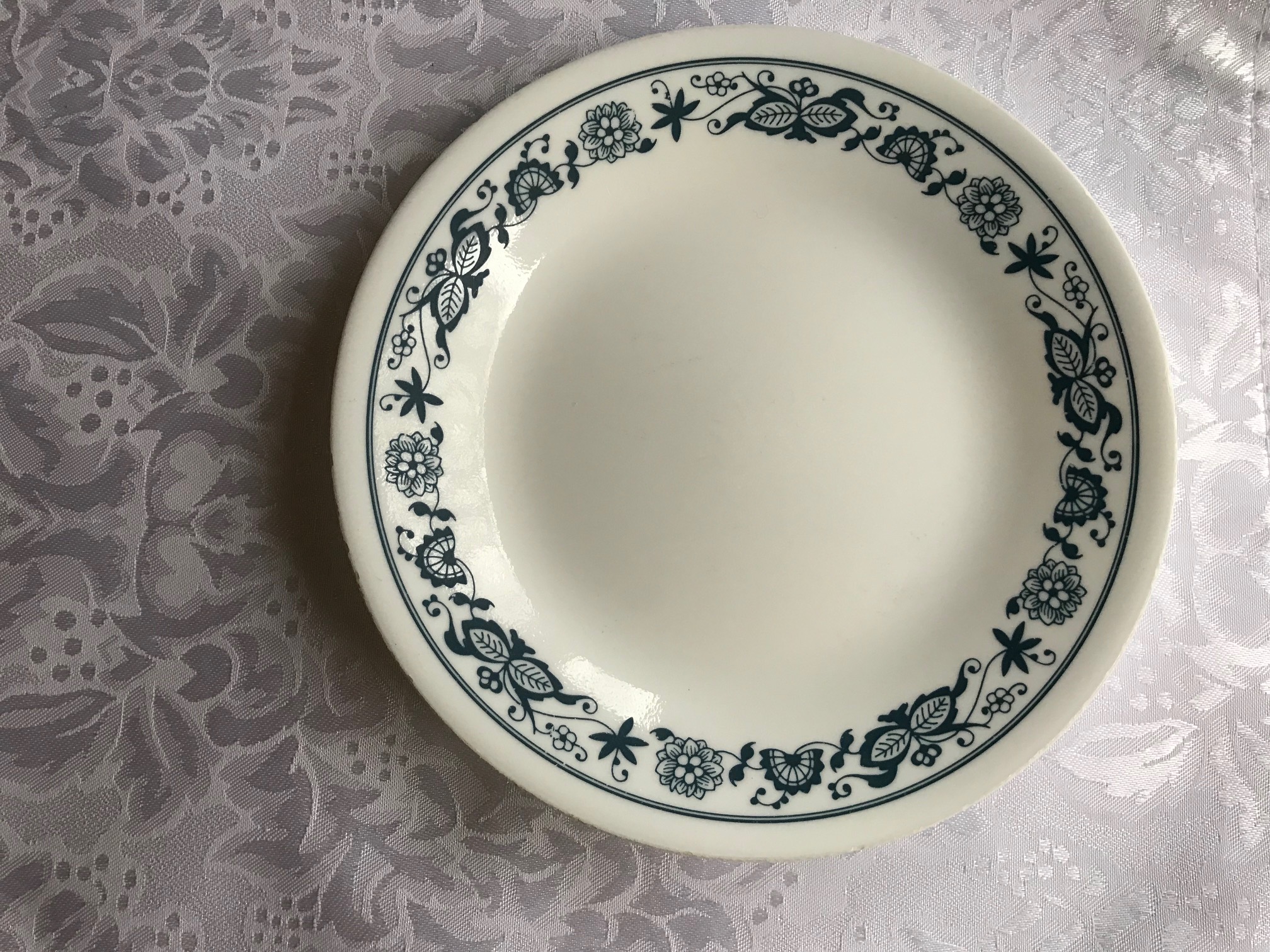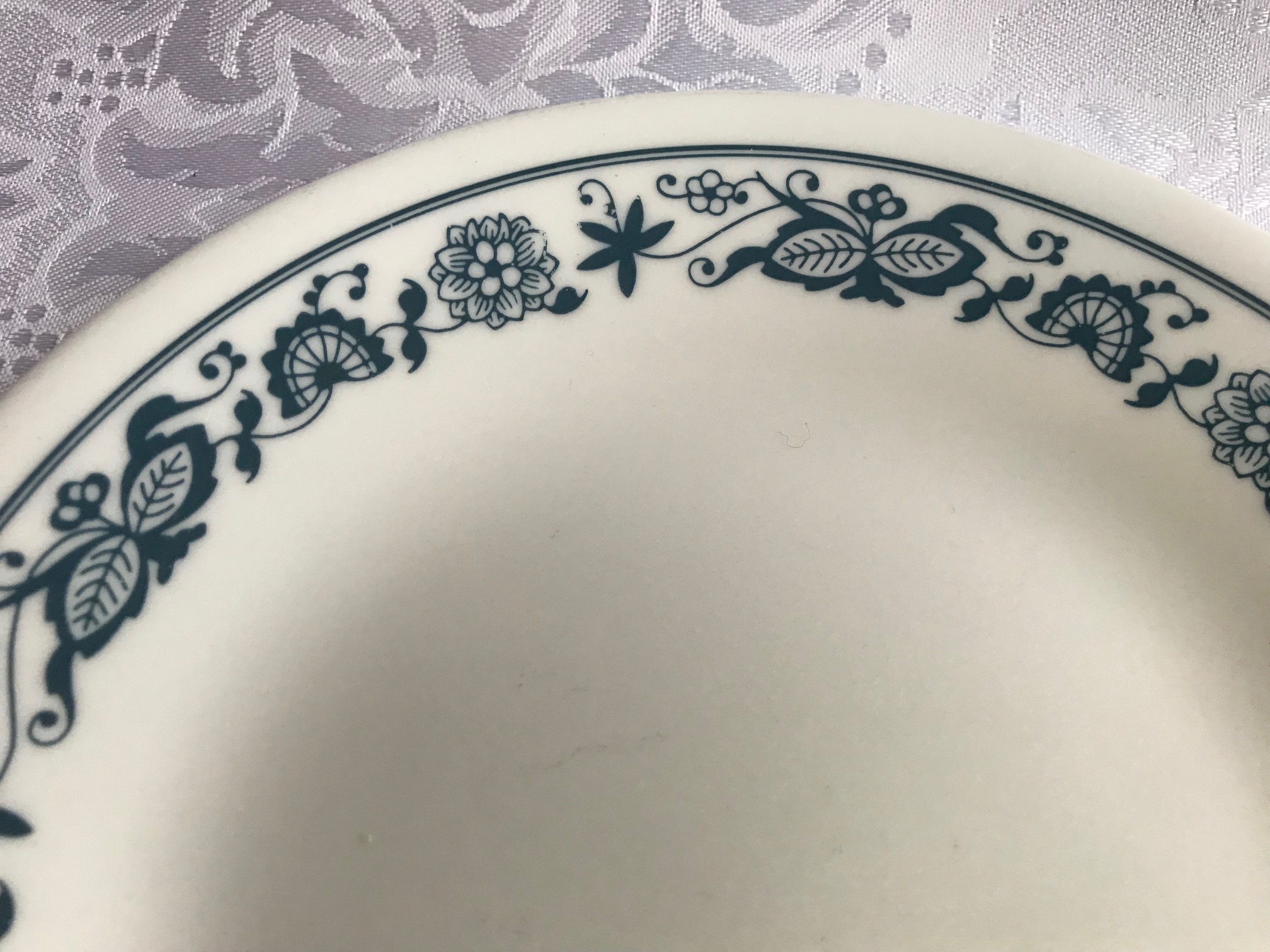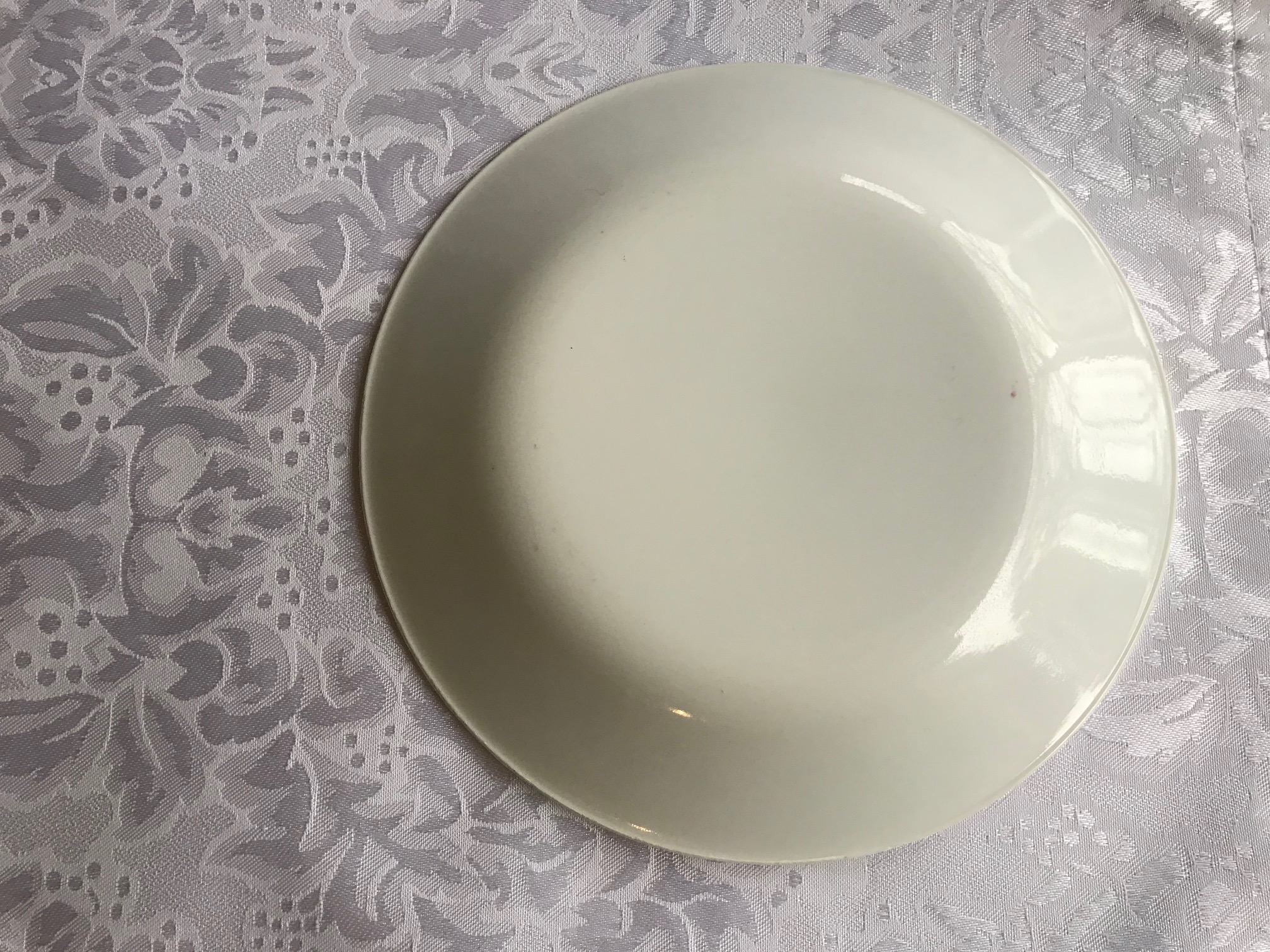“Old Town Blue” Pattern Vintage Corelle Small Plate, c.1972-1982: 18,200 ppm Lead (90 ppm and up is unsafe for kids)
For those new to this website:
Tamara Rubin is a multiple-federal-award-winning independent advocate for childhood Lead poisoning prevention and consumer goods safety, and a documentary filmmaker. She is also a mother of Lead-poisoned children (two of her sons were acutely Lead-poisoned in 2005). Since 2009, Tamara has been using XRF technology (a scientific method used by the U.S. Consumer Product Safety Commission) to test consumer goods for toxicants (specifically heavy metals — including Lead, Cadmium, Mercury, Antimony, and Arsenic). All test results reported on this website are science-based, accurate, and replicable. Items are tested multiple times to confirm the test results for each component tested. Tamara’s work was featured in Consumer Reports Magazine in February of 2023 (March 2023 print edition).
- Lead (Pb): 18,200 +/- 400 ppm
- Cadmium (Cd): 133 +/- 13 ppm
- Arsenic (As): Non-Detect / Negative
- Mercury (Hg): Non-Detect / Negative
- Barium (Ba): Non-Detect / Negative
- Chromium (Cr): 3,433 +/- 164 ppm
- Antimony (Sb): Non-Detect / Negative
- Selenium (Se): Non-Detect / Negative
- Zinc (Zn): 94 +/- 24 ppm
- Copper (Cu): 106 +/- 41 ppm
- Nickel (Ni): 594 +/- 98 ppm
- Iron (Fe): 816 +/- 157 ppm
- Titanium (Ti): 5,290 +/- 260 ppm
- Zirconium (Zr): 3,256 +/- 96 ppm
- Platinum (Pt): 320 +/- 95 ppm
- Cobalt (Co): 4,890 +/- 252 ppm
- Manganese (Mn): 770 +/- 256 ppm
- Gold (Au): Non-Detect / Negative
#LeadSafeMama
*Amazon links are affiliate links. If you purchase something after clicking on one of Lead Safe Mama, llc’s links, Lead Safe mama may receive a small percentage of what you spend at no extra cost to you. Thank you for supporting OUR advocacy work in this way. 

Never Miss an Important Article Again!
Join our Email List












Hi,
I’m wondering about the more modern new-stock of this specific design.
My grandma filled in missing pieces my mom’s vintage set when I got married in 1997.
In about 2016, I replaced a few that had gotten broken after the wedding.
Of course, I’m not going to be able to tell the difference between the vintage plates and my new-stock, but would the modern ones be at lower lead levels?
Hi Maria,
Patterns I have tested through as late as the year 2,000 were still positive for high levels of lead. Since they are not marked with the year it is a little tricky to determine years of production.
Tamara
I notice it is not a recall from Corning, nor are the offering compensation or replacements.
That is correct – no recall, no official public acknowledgment. But obviously true (I share with detractors that if it were not true, they would have served me with a law suit or a cease and desist order or something… which I am not worried about because I have science on my side!)
T
I’m just confused. I have used this exact set since I was born in 1995. Literally have this large plate sitting next to me after having eaten a cheese omelette on it. You would think if there was a problem with this set people would be experiencing a lot more problems. You would think at least one or two people would be in the hospital with lead poisoning. But yet no one is. Very strange. No?
Anna, I’m with you. We had this set for as long as I can remember, and raised our three children using them. With no side effects. Maybe we’re lucky, but I have NEVER heard this before.
Hi Tamara! Thanks so much for what you do. I just inherited a beautiful vintage “Currier and Ives” set (Old Grist Mill) which features blue artwork and pictures on each piece. I’m assuming from what you found on this piece that most antique dishes with print (blue or otherwise) contains high levels of lead and should not be used on a daily basis. Is that correct?? I love this set, but also want my family (especially little kids) to be safe. Thanks in advance!
I inherited the same set, Currier and Ives Old Grist Mill Underglaze print (whatever that means) it’s by Royal and made in the USA.
So it’s only the blue paint that is positive for all those things? Or the entire plate. I am just so upset that I’ve been using these since I was a kid at my grandma’s an then inherited them!. Now I feel like I have been giving my kids breakfast lunch and dinner with a side of lead mostly and all the other scary things listed! Thankfully they haven’t used them as long myself! But still taking them out the closet an ordering a new set now!
Yes – it is the painted areas. Please do read this post for context (#KnowBetterDoBetter): https://tamararubin.com/topics/does-vintage-and-new-functional-pottery-and-dishware-have-unsafe-levels-of-lead/
Tamara
I have the entire set gravy boat platters,serving bowls,everything….my grandma used daily until I was about 13 and she put them in my Hope chest….I’ve always displayed in China hutch and used for thanksgiving.
Regarding the Vintage Corelle glass saucer in the “Old Town Blue” pattern, does it only affect the glass saucer size, or all size plates? I’m thinking it’s all sizes affected since the same paint was used. They come in saucer size and lunch plate, too. Thanks.
I’m guessing since you found lead on one plate the whole set has lead decorative paint.
Hi Hope!
All of the ones I have tested with this pattern have been positive for Lead, here’s the category link to the posts that are currently up on the site: https://tamararubin.com/category/old-town-blue/
Tamara
How is this still legal??? We bought this pattern about 5 years ago. Corelle is a mainstay of American dishware and I’d bet it can be found in 50% of homes.
I have had some for a long time , i can appreciate the numbers and concerns but i have a few thoughts : after 40+ years the colours have not faded or peeled in any way , could this imply that the paint is stable and not releasing important amounts of chemicals as it would surely have degraded after decades if it was , also a simple thought : my food is in the centre of my plate , no paint there . Also seems strange that public health and authorities from all over the world have not flagged this as very dangerous ? What are your testing methods , do you grind off paint for testing ? What independant labs are doing the analysis . Any tests done for normal use , ie soaking a plate in water for a time and checking the water for leaching chemicals ?
Please do read the full overview post for starters – all your questions are answered there (either directly on the post or through links about certain sub subjects related to your questions): https://tamararubin.com/2019/12/breaking-news-12-26-19-corelle-recommends-using-their-pre-2005-dishes-only-as-decorative-pieces-due-to-concerns-for-high-levels-of-lead/
None of the questions they asked were answered in the post and I am not going to be trying to navigate a bunch of random links to find something that should be in the post.
Which questions are you looking for answers to? There is a search bar on every page and you just put keywords in to find the answers. This post has some additional information about these types of plates:
https://tamararubin.com/2019/12/corelle-plate-with-crazy-daisy-spring-blossom-green-border-pattern-15200-ppm-lead-cadmium/
This is the post with the warning from the manufacturer:
https://tamararubin.com/2019/12/breaking-news-12-26-19-corelle-recommends-using-their-pre-2005-dishes-only-as-decorative-pieces-due-to-concerns-for-high-levels-of-lead/
This post discusses the overarching problem:
https://tamararubin.com/topics/does-vintage-and-new-functional-pottery-and-dishware-have-unsafe-levels-of-lead/
This post discusses the testing methodology used here on this website:
https://tamararubin.com/2016/12/ask-tamara-what-do-you-use-to-test-for-lead/
This post has a video that shows you how to search the website efficiently:
https://tamararubin.com/2020/12/how-to-use-the-lead-safe-mama-website-video/
Let me know if you don’t find the answers you see there.
Tamara
Most of those links (shared with you today) are in the post above or the linked post in the initial response.
Tamara
Hi Tamara i just recently purchased a vintage old town blue corelle set + pyrex in an auction. I dont know what year it was made. How can i tell if it was made pre-2005?
Unfortunately that’s one of the problems – they are not marked with the year of manufacture, so you really cannot know. There is some variation in the back marks but not enough to note specific small date-range periods. You could try comparing the back marks on yours to some of the back marks on examples here on my website. Any of the examples with high lead will be pre-2005 and I have back mark photos for most examples I have published.
T
Is the Meadow pattern one that contains lead?
Hi, we have 20 place settings in the blue but purchased them new in the last 8 years or so. Since it says pre 2005, are the newer ones safe?
I have vintage old town blue Corelle which I am discarding. However I wonder if the bowls which have the blue design on the outside of the bowl are dangerous to use.
Tamara, what about the blue mugs that come with the set? I have always been suspicious of the blue paint. Hope you can put my fears to rest. Thanks for championing this cause!
Hi there Sophie – those are equally toxic (sorry to say!)
Tamara
I also have to let go of my old town blue dinnerware set after my son came home from grad school and refused to eat off of any pieces of it. I have ordered a new set of Madeline by Corelle, but not before writing an e-mail to Instant brands which now owns corelle Now I have to research all the Corning pieces I own along with all the other dinnerware I own.
Thank you Tamara for all the important work you do!
I love this comment. Thank you for sharing.
T
I received a set of these dishes as a wedding gift in Dec 1982. Since then, I have bought others to replace the ones broken over the years. When I look on the back for markings, I find some have no markings at all and others say Corelle. Does this mean anything?
Unfortunately no – it is difficult to tell the age for these dishes. I have not found any from this pattern that have been negative for Lead.
Tamara
Thanks for the great article! One question though…
While I get that lead and cadmeium (and the other stuff) are bad to ingest, period, do you know what the ppm maximums are for adults? (In other words, at what level would you have displayed them in red if kids were not in the picture?) My 85-year-old mother has a couple of the Old Town Blue pieces that she uses regularly (they’re in good shape — not chipped or faded) and I’d rather not call and tell her not to use them anymore if the level they’re at isn’t too unsafe for her.
Oh, and I discovered another potential reason not to use the Corelle…. One time I was staying with her and I dropped one of those dishes on a thick shag carpet (from the 70s ) and it literally exploded into thousands of tiny shards! I’ve never seen anything like it before and it took forever to get them all up (using my fingers, a regular vacuum, a hearty-duty hand vacuum, and, unfortunately, my feet/socks a few times, to pick them all up).